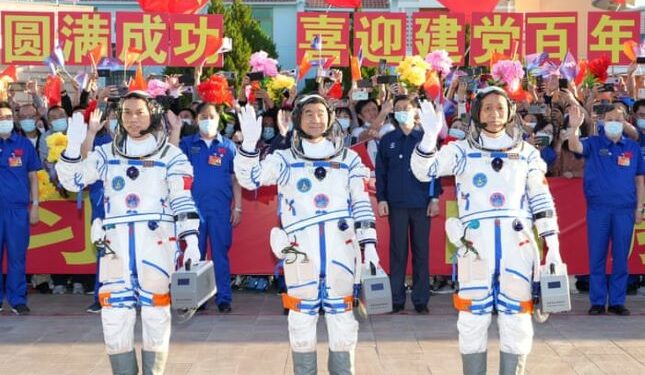
By Helen Davidson/The Guardian
Taipei, June`17 : China’s first crewed spacecraft in nearly five years blasted off from the Gobi desert on Thursday morning, carrying astronauts to the new Tiangong space station.
A Long March-2F rocket carried the three astronauts in the Shenzhou-12 spacecraft, and was expected to dock with Tianhe, the main section of the Tiangong station, about six to eight hours later.
The astronauts, Nie Haisheng, 56, Liu Boming 54, and Tang Hongbo, 45, had earlier been honoured in a modest ceremony at the Jiuquan satellite launch centre. It is China’s first human mission to space since 2016, and the longest ever scheduled, with the team expected to be on Tiangong (Heavenly Palace) for three months. Previous Chinese missions have been a month at most.
Construction of Tiangong began in April, with the launch of its first module, Tianhe. The crew will live on the cylinder-shaped module measuring 16.6 metres by 4.2 metres while carrying out further construction missions.
The module has separate living spaces for each of them, a treadmill for exercise, and a communication centre for emails and video calls to ground control.
On Wednesday, the crew appeared before the media. Sitting behind glass, dressed in uniform, they said the mission was expected to be complex. Nie, the mission leader, has previously been to space twice, and Liu once. Thursday’s flight marked Tang’s first trip.
“There are many tasks … the tasks are arduous and there will be many challenges,” said Nie. The Hubei-born former airforce pilot will be the oldest Chinese astronaut to ever go into space. He said every step carried “the heavy expectations of the party and the people of China”. “Every step will contribute to the strength of the Chinese people and the peaceful use of space by mankind.”
The launch represents a matter of huge prestige in China, as Beijing prepares to mark the 100th anniversary of the ruling Communist party on 1 July with a massive propaganda campaign.
The launch was broadcast across state media, from take-off until they reached orbit, with internal shots of the cabin where the astronauts smiled as some items floated in zero gravity around them.
Jonathan McDowell, an astronomer at the Harvard Smithsonian Center for Astrophysics, said the launch appeared to go smoothly, and noted China gave it far more extensive coverage than previous human space flights, suggesting a high level of confidence.
“It’s not to say we should expect same level of confidence at all stages of the mission,” he said. “The trickier things are the things they don’t have much practice doing.”
The first will be the rendezvous and docking at Tiangong, which McDowell said was straightforward but didn’t preclude potential issues with navigation or thrusters.
In Wednesday’s press conference, officials had made specific note of improvements to the landing target technologies.
During the mission the astronauts will conduct two spacewalks – more than on any previous mission – and run various experiments including testing a new robot arm, and regenerative life support systems.
“They’re going, from day one, all-in to be much more aggressive in their use of this space station,” said McDowell. “They’ve got two experienced astronauts and one newbie, and that makes sense for what’s essentially a test flight to the new station.”
To prepare for the mission, the crew has undergone more than 6,000 hours of training, including hundreds of underwater somersaults in full space gear.
“The challenges will not be absent. For this reason we have conducted comprehensive and systematic training,” Liu said on Wednesday. “No matter how hight the risk is, I firmly believe that with the support of professionals and the cooperation between the three of us … we’ll complete every mission.”
US law bars Nasa from cooperating with Chinese astronauts, meaning none have ever been to the International Space Station (ISS), a collaboration between the US, Russia, Canada, Europe and Japan. On Wednesday, officials said China expected foreign and Chinese astronauts to jointly participate in the Chinese space station. McDowell said China’s plans were not for full international cooperation and interdependence, as with the ISS, but more likely centred on offering to run experiments on the Chinese station for other countries, or hosting astronauts.
The ISS is due for retirement after 2024, though Nasa has said it could remain functional beyond 2028. Tiangong is to be much smaller than the ISS and expected to have a lifespan of at least 10 years.
“What’s going to be interesting is at the end of the three months, will they bring the crew down and have it empty … or do a handover in orbit the way they do on the ISS?” said McDowell.
McDowell said the next mission was set to last six months, so it appeared they were “beefing up their experience in keeping humans in space for long periods in time, and maintaining an active space station for long periods of time”.
“I think they’re moving towards … a permanent human mission in space … and the next few months will be critical to check everything’s working to let them do that.”
